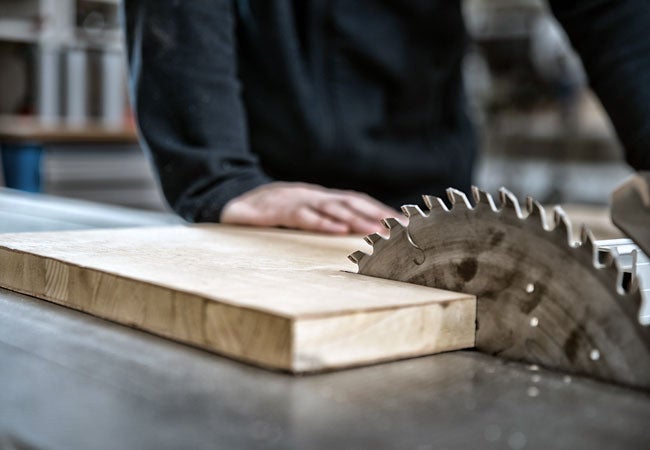Master the info and techniques here to ensure safe, efficient, satisfying work
with this popular power tool.
Anyone serious about woodworking or DIY eventually wants to add a table saw to their power tool arsenal. Named for the table that supports the material being cut, the table saw is an excellent tool for making quick, precise work of repetitive cutting tasks. If you’re in the market for one of these beauties or just bought one for your home workshop, study up here on how to use a table saw to make cuts correctly and safely.
Table Saw Basics
Table saws, which run between $300 for a standard model to $700 for a contractor-quality version, are sold by the size of the blades they accommodate. The 10” size is most common and ideal for most carpentry and woodworking tasks, yet you’ll find 8” table saws that are handy for small work and 12” versions well suited to creating deeper cuts on thicker material. The parts of a table saw include:
A table top of at least 3’X3’ (possibly larger than 4’X6’) with extensions available for most brands. The table, typically made from cast steel or cast aluminum, rests on a stand or a metal cabinet. Most table saws are considered stationary power tools, but portable versions with foldable legs for easier moving are available.
A blade that can be raised or lowered via a blade-height crank
A rip fence, which is a guide bar positioned parallel to the saw blade
A miter gauge that assists the user in making crosscuts
Blade guards that encase the blade while it’s cutting to offer a measure of protection in case your fingers get close to the blade
Push sticks that allow you to feed the material through the saw without your fingers getting close to the moving blade
Depending on the saw you choose, you may have additional accessories such as rollers or table extensions to support long lengths of wood, vacuum attachments, or clamps.

Photo: istockphoto.com
Safety First
Too many weekend warriors—and pros—have suffered serious injuries for not knowing how to use a table saw. If not properly handled, the material being cut can get in a bind and kicked back, either throwing the material at a high velocity toward them or jerking it violently and pulling their fingers toward the blade. To lessen the risks of kickback:
Never start the saw while the material you’re cutting is touching the blade.
Always use the rip fence when making “rip” cuts.
Always use the miter gauge, not the rip fence, for crosscuts (the rip fence doesn’t offer adequate support).
Keep material completely flat against the table during the cut.
In addition to the specific safety observances to prevent kickback, take the time read the manufacturer’s safety provisions and be sure to always wear goggles and ear protection while using the table saw. Also remember to unplug the saw before you adjust or align the blade, and don’t remove the safety guards that come with the saw.
Making the Cuts
With accessories such as clamps, stops, and jigs, you can make such specialty cuts as dado cuts, compound angles, and rabbet joints—yet woodworkers rely on the table saw most for two basic cuts. Ripping, the most common use of a table saw, involves cutting material to a specific width. Crosscutting applies to cutting material to a specific length. Below, you’ll find step-by-step directions for using a table saw to make each of these common cuts.
ICW SOLUTION Since 2004 Manufactured And Marketed
A comprehensive range of technologies and solutions for Furniture | Doors | Cabinets.
 ch
ch English
English






